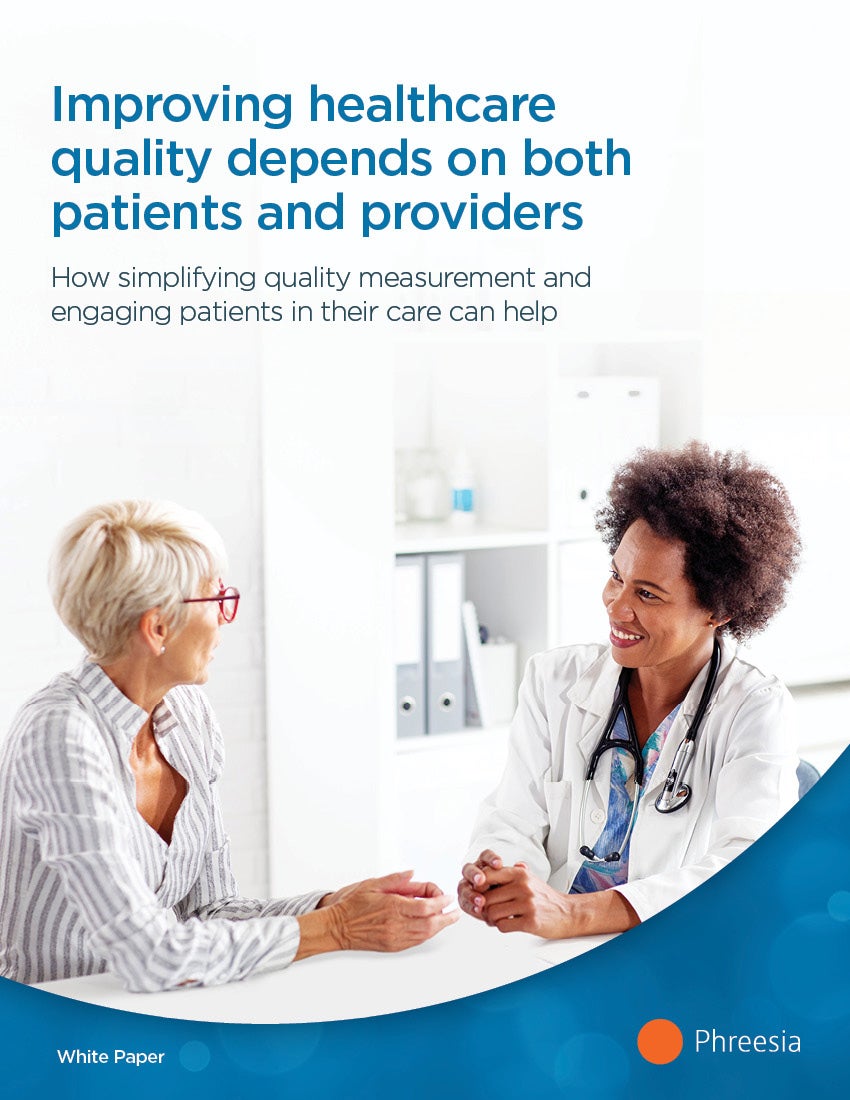Improving healthcare quality is a critical goal for patients, providers, payers and policymakers. But efforts to simplify the quality measurement system in the U.S. have had limited success, largely because our system of quality reporting often ignores the role of patients and treats them as passive recipients—rather than active participants—in their care.
Fortunately, there are proven, effective ways to support patients in becoming active participants in their care—and in turn, improve healthcare quality.
In this white paper, we explore:
- The role of the Universal Foundation in streamlining quality measurement
- Why helping patients self-manage their health is key to delivering better care
- Strategies for delivering person-centered care to meet patients where they are
Click the image to download the white paper.
Improving healthcare quality depends on both patients and providers
How simplifying quality measurement and engaging patients in their care can help
Executive summary
Improving healthcare quality is a critical goal for patients, providers, payers and policymakers. But efforts to simplify the quality measurement system in the U.S. have had limited success. The Universal Foundation, a Centers for Medicare and Medicaid Services (CMS) initiative to streamline quality measurement by focusing on health conditions that impact large sections of the population, is a key step in the right direction. To fully achieve goals of improving outcomes and advancing equity, the Universal Foundation should focus on quality measures that engage patients in their care.
This is because our system of quality reporting often ignores the role of the patient and treats them as passive recipients—rather than active participants—in their care. But there are proven, effective ways to support patients to become active participants in their care, and simple digital tools can streamline this process.
To fully achieve goals of improving outcomes and advancing equity, the Universal Foundation should focus on quality measures that engage patients in their care.
The Universal Foundation and quality measurement
Over two decades into the shift from fee-for-service to value-based care, the U.S. healthcare system has yet to realize the full potential of the quality improvement movement. That’s because overstretched, burned-out providers barely have enough time to address the chronic and acute needs of their patients—and reporting on quality measures only compounds their list of time-consuming responsibilities.
There are more than 300 quality measurement and improvement activities in CMS’ Merit -based Incentive Payment System (MIPS)—and MIPS is just one of 27 quality programs, all of which use different measures of quality. The sheer number and complexity of the quality measures can be overwhelming for providers and healthcare organizations. Moreover, inconsistency between programs and payers makes it difficult to effectively measure quality and standardize reporting.
To address these challenges, in spring 2023, CMS introduced a “Universal Foundation” of quality measures—an initiative designed to streamline measures across all the agency’s quality programs and, in turn, reduce reporting requirements for providers.1 By selecting measures that are “meaningful for the health of broad segments of the population, ” the Universal Foundation provides a strong base for streamlining quality measurement and advancing health equity, especially for primary care providers and pediatricians.
For example, the Universal Foundation selects measures that address the most common causes of morbidity and mortality, like diabetes, high blood pressure and cancer, as well as measures that focus on high-quality preventive care and care coordination. Children and adolescents are experiencing depression, anxiety and other mental health conditions at high rates, especially in the aftermath of the pandemic; the Universal Foundation emphasizes improving quality in behavioral healthcare for pediatric populations.
Focusing on measures that are broadly applicable will help to streamline quality measurement, but improving healthcare quality takes more than that, because many quality measures hold providers accountable for a factor beyond their control: how patients behave.
The core challenge: Changing patient behavior
The administrative tasks associated with quality measurement place a significant burden on healthcare providers and don’t always translate to the delivery of better care. That’s because reporting on quality metrics alone isn’t enough to ensure patients are getting the care they need—providers must also encourage patients to undertake behaviors to self-manage their health.
These behaviors include, but are not limited to:
- Seeking preventive care when it’s due (e.g., cancer screenings, immunizations)
- Managing chronic conditions (e.g., hypertension, diabetes)
- Addressing social drivers of health (SDOH)
Changing patient behavior is complicated because providers can’t directly control what patients do—especially after a medical visit ends or if a patient doesn’t come in for a check-up in the first place. As a result, providers often view patient behavior as an obstacle to improving healthcare quality. In fact, one study found that most primary care providers (PCPs) do not see the value in trying to support patient self-management, and many are frustrated that patient behavior may affect their compensation.2
Being held accountable for someone else’s behavior is especially frustrating for providers who are already strapped for time.
On average, PCPs would need an estimated 27 hours per day to give each patient the comprehensive preventive, chronic disease and acute care they need.3
Even if these tasks were divided among multiple providers, they would all need training on how to collect patient-reported outcome measures, screen patients for social needs, record patient responses in the organization’s electronic health record (EHR) and flag patients who may be at higher risk for certain medical conditions. Each screening takes several minutes to complete and document—and that’s without accounting for necessary follow-ups, discussions and/or referrals.
Even then, patients still have the autonomy to make their own decisions about their health. Inevitably, some patients will not follow through on recommended care—and providers are held accountable for those patients’ inaction. That doesn’t mean patients are at fault. Being a savvy patient is a learned skillset—and not one that’s taught. Instead, patients are expected to learn how to self-manage their care in real time, often while they’re navigating a health issue that can be overwhelming or life-threatening while contending with the demands of everyday life.
What if providers had a tool to help patients self-manage their health? If the U.S. healthcare system focused on helping every patient gain the knowledge, skills and confidence to manage their own health—what we call patient activation—providers would be better positioned to succeed on quality measurement.
Streamlining quality measurement: Strategies for success
Effective quality measurement lies as much with patients and their families as it does with providers. That’s why it’s critical to deliver person-centered care—an approach that tailors and individualizes care to each patient, taking into consideration their unique needs, preferences, values and beliefs.
Here are some ways providers can deliver person-centered care to meet patients where they are:
Focus on patient activation
Being a patient is hard work, especially for individuals with complex or chronic conditions. Some patients are further along in their journey of asking questions, taking medications as prescribed and practicing healthy behaviors, while others need more help. But without a reliable way to identify which patients need the most support, providers may struggle to meaningfully engage them in their care—or equip them with the self-management resources they need to achieve optimal health outcomes.
That’s where patient activation, measured through the Patient Activation Measure® (PAM®), comes into play. The PAM is a survey that assess patients’ knowledge, skills and confidence in managing their own health and healthcare. It segments patients into one of four levels that help providers understand whether a patient is overwhelmed and discouraged in managing their care (Level 1) or goal-oriented and proactive (Level 4).
Patient activation gives healthcare organizations an objective and realistic understanding of patients’ ability to take responsibility for their health, which in turn help providers tailor their interventions for each patient. Low-activated patients, for example, may benefit from setting small, tangible goals to grow their confidence over time. Higher-activated patients, by contrast, may see greater benefit from more complex, self-directed goals.
Since the PAM is predictive of many clinical quality measures, integrating it into the Universal Foundation would help to streamline our system of quality measurement.
Put simply, if providers move the needle on patient activation, they will likely move the needle on other quality measures, in turn leading to improved outcomes.
One study found that for every 10 points gained in patient activation, patients saw a 1% lower predicted probability of having an emergency department visit, having obesity or smoking—and a 1% higher likelihood of having a breast cancer screening or clinical indicator (i.e., A1c, HDL and/or triglycerides) in the normal range.4
Engage patients when their healthcare is top of mind
Preventive care saves lives because it ensures that people stay healthy rather than treating them when they are sick. Using technological solutions to help deliver preventive care simplifies and reduces the burden on providers and makes it easier for them to focus on the health issues that are most pressing to patients during the appointment.
For example, sending automatic digital reminders and education can help patients be proactive about getting vaccines and cancer screenings, instead of relying on providers to discuss preventive care. Phreesia’s platform can remind patients about overdue care precisely when their health and healthcare are top of mind: as they’re checking in for a visit. By using the “nudge” principle of behavioral economics, which uses human psychology to clearly present information and leads people to make better decisions, Phreesia prompts patients to request or self-schedule appointments for necessary preventive care.
Engaging patients and simplifying preventive care helps streamline quality measurement because most—if not all—patients need those services at some point in their healthcare journey.
On Phreesia’s platform, 1 in 5 patients request a flu vaccine during their visit after seeing a reminder during check-in, and 30% of patients request a mammogram when they’re checking in for a visit. Because Phreesia facilitates more than one in ten patient visits in the U.S. each year, its automated platform has the potential to improve health outcomes for millions of people.
Conclusion
The Universal Foundation is key to simplifying quality measurement, but it is a base upon which healthcare organizations can build, using tech-enabled tools that already exist. Moving forward, policymakers should continue to focus quality improvement efforts on providers and patients, because better health outcomes and reduced costs depend on both the care providers deliver and how patients behave. That’s why mechanisms to support patient activation are key to quality measurement.
Ultimately, care teams want to use quality measures that enable them to deliver better care, and digital tools can help them achieve this while significantly reducing the administrative burden on providers. The success of the Universal Foundation measures in streamlining quality measurement and reporting rests on the interaction between patients and providers. The way to ensure the most meaningful impact is to help patients become active participants in their care.
About Phreesia
Phreesia is the trusted leader in patient activation, giving providers, life sciences companies, payers and other organizations tools to help patients take a more active role in their care. Founded in 2005, Phreesia enabled approximately 150 million patient visits in 2023—more than 1 in 10 visits across the U.S.—scale that we believe allows us to make meaningful impact. Offering patient-driven digital solutions for intake, outreach, education and more, Phreesia enhances the patient experience, drives efficiency and improves healthcare outcomes. To learn more, visit phreesia.com.
End notes
1. “Aligning Quality Measures Across CMS – the Universal Foundation,” Centers for Medicare and Medicaid Services, March 13, 2024.
2. Hibbard JH, Greene J, Sacks R, Overton V. Does Compensating Primary Care Providers to Produce Higher Quality Make Them More or Less Patient Centric? Medical Care Research and Review. 2015;72(4):481-495. https://doi.org/10.1177/1077558715586291
3. Porter J, Boyd C, Skandari MR, Laiteerapong N. Revisiting the Time Need to Provide Adult Primary Care. J Gen Intern Med. 2023;38, 147-155. https://doi.org/10.1007/s11606-022-07707-x
4. Greene J, Hibbard JH. Why Does Patient Activation Matter? An Examination of the Relationships Between Patient Activation and Health-Related Outcomes. J Gen Intern Med. 2012;27(5): 520–526. https://doi.org/10.1007%2Fs11606-011-1931-2






